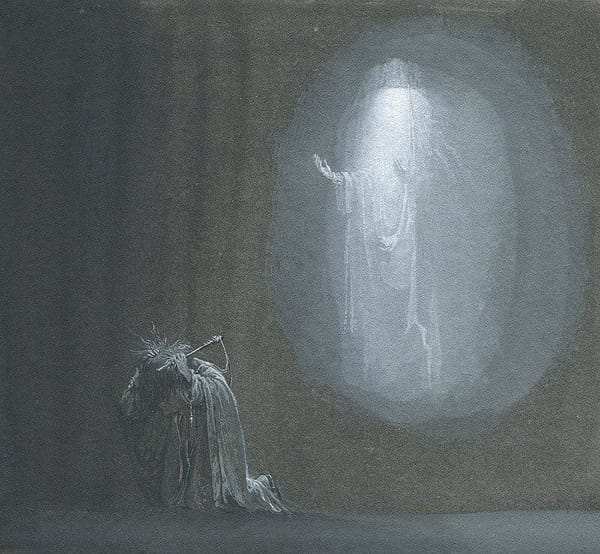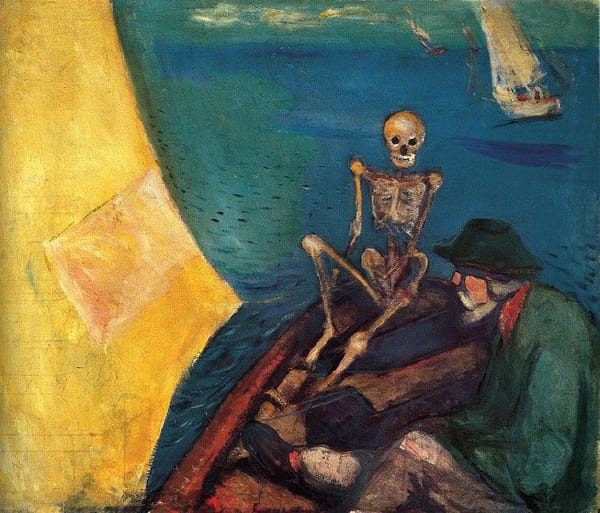
Today we continue our ongoing series on the question of self-destructive behaviors in humans, and especially the role of fantasy, desire, and the ego play.
Academics and lay theorists alike have been re-discovering Rene Girard lately.
His theories have attracted attention for their shocking relevance to our modern lives in which we find ourselves increasingly disoriented by the dynamics of social media, the libidinal logic of advertising, and the continual escalation of tribal politics [1].
Girard spent his academic career developing and evangelizing a system which he claimed offered a unified theory of desire, imitation, and violence. While his mimetic theory is sparing in its premises, it excels in explanatory power and range of efficacy.
For our purposes, this essay approaches Girard's mimetic theory of desire exhibits uncanny parallels to Lacan's own formulations on desire, even leading us to the threshold of his insights concerning the emptiness (and resulting infinity) of desire and the function of fantasy.
In particular, I'm interested in how a Lacanian supplement to Girard provides an illuminating angle from which we can approach the primary theme of our investigation for the past few weeks. -- the question of self-destructive behavior in humans.
Girardian Desire
Girard locates the genesis and logic of human desire in imitation (mimesis).
We observe another human desiring an object, and we consequently adopt them as a model to imitate, thus beginning to desire the objects which they desire. We take the object to be desirable by virtue of the Other desiring it.
Our desire is the desire of the Other, possessing a triangular structure involving three terms (subject <model> object), rather than the direct relationship between subject and object.
This triangular structure introduces rivalry into the heart of desire.
If (an)Other is always present in my relationship with the object of my desire, this mediatorship has the potential to create violent conflicts and profound ambiguities.
This source of antagonism provides Girard with a point from which he can elaborate the dynamic relationship between desire and violence.
In the mimetic relationship, the model paradoxically serves as the exemplar to be imitated, but also as the obstacle to be overcome in order to acquire the desired object. The model becomes both idol and rival.
A whole tempest of emotions and subjective strategies flow from this contradictory situation wherein the desiring subject experiences the double bind of two simultaneous but contradictory injunctions -- "Be like your model!" "Do not be like your model!"
Girard theorizes that a modulation in distance (social, physical, chronological) between the model and the imitator can produce either a less intense "external mediation" of desire which can manage to avoid the more destructive possibilities inherent to the mimetic relationship, or a potentially debilitating "internal mediation," which can produce intense suffering through jealousy, hatred, envy, and diverse psycho-pathologies.
Too much proximity to one's model suffocates the imitator, whereas sufficient distance allows enough breathing room to buffer the imitator from the painful demands of rivalry.
To be clear though, desire puts the desiring subject in a harrowing situation — in order to acquire what they desire, the imitator must kill the very person which makes their object of desire desirable.
Success is the true horror here, and much like Oedipus, the imitator runs the risk of finding themselves with their revered father's blood on their hands and their aged mother in their bed. Yes, success must be avoided at all costs.
Much better to go on desiring in a state of intense suffering and frustration than to snuff out desire's flame through obtaining the object of desire once and for all.
The mimetic relationship is thus marked by a violent vacillation in which one must simultaneously attempt to acquire the desired object while nonetheless keeping desire alive through continual conflict with the rival. This conflicted state of affairs leads the desirer to ever more tortured coping mechanisms for their ongoing frustration.
Desiring to desire
Crucially here, I believe, we can make a deduction which explicitly articulates the drive which gives the teeth to the mimetic double bind Girard describes the desirer as experiencing — the desirer’s true desire is desire itself, which is to say, their true desire is to go on desiring.
If the lover’s true desire was actually to acquire the desired object, they would simply do so. The fact that they do not, and instead choose intense suffering in which they are prevented from acquiring the object of desire, betrays the true root of their behavior — they value desire itself above and beyond the object they purport to desire.
They would rather go on desiring than acquire what they purport to desire, thus indicating the primacy of desiring over satisfaction. [2]
While Girard does not articulate his own theory in terms of “desiring to desire” or "the desire to desire," he seems to display an intuition of this dynamic in his investigations of myth-making and the phenomenon of the scapegoat.
Girard devotes much of his work to understanding the dangers which mimetic desire poses not only interpersonally, but also socially. He primarily sees mimetic desire operating in more primitive societies in the potentially devastating feedback loop created by the desire for revenge.
In the infinite game of vengeance, every act of vengeance which is enacted from the desire to achieve recompense for past violence itself amplifies the cycle of violence into a continual game of one-upmanship.
The game of vengeance has the terrifying potential to spread like a plague as family members and friends continually retaliate for violence perpetrated against their kin. The only theoretical limit for this game is if humanity were to reduce itself to a single person through bloodshed.
Girard argues that the mechanism of the scapegoat functionally solves this social dilemma by creating a single individual on which the community can exhaust its desire for vengeance, and thus the sacrificial function of the scapegoat provides protection for society against the threat of mimetic feedback loops.
However, Girard observes, the scapegoat and their sacrificial function requires the production of a myth or myths to make sense of the community’s actions and justify their violence against the victim.
A myth here plays the role of a fantasy which the community imagines and repeats for itself, thus re-founding its own identity which the infinite game of vengeance put in jeopardy.
Re-stated in the terms I'm employing here, we can say that the community wishes to go on desiring, but it requires the imposition of the otherness of law to cut this desire short, for desire within itself does not possess any mechanisms for self-limitation., for it simply is the desire to continually perpetuate itself as desire.
From myth to fantasy
Girard’s theories rely heavily on the notion of fantasy, and while we can see this clearly in his work on scapegoats and myth-making, he seems to neglect exploring fantasy’s operation at the individual level.
He does not plumb the implications of the inextricably fantastical dimension of desire because, I believe, he does not sufficiently interrogate the incompleteness of the imitator's relationship with their model.
How does the imitator know that the model desires the object?
On what basis does the imitator know what desire is at all?
What gives the imitator warrant to take the scene they have witnessed as staging desire, rather than another emotional state, or even a deception?
On what basis does the imitator interpret their model as demonstrating how to desire?
Lacanian analyst Moustafa Safouan observes that "desire is an interpretation of the Other's desire."[3] Here, we find ourselves speaking about a hermeneutic.
Fantasy provides the interpretive mediating point between the observer and the original scene in which the model is taken as a model of desire.
Fantasy puts a meaningful narrative frame to the scene in which the imitator adopts the Other as a model of desire, and thus serves to orient them to the object of desire by way of orienting them to the Other.
As noted earlier about the triangular nature of desire, our desire is always also a dynamic positioning vis a vis the Other and their desire.
We can infer the incompleteness of the imitator's relation to the model from at least two observations, the first banal, but the second dictated by the logic of Girard's theory.
First, we simply are not "in the mind" of the Other, and thus we presume to understand their intentions when we take them to be exhibiting desire. The imitator always makes an interpretive leap of some sort. Wittgenstein's "beetle in a box" thought experiment points us in this direction.
Secondly, and more importantly for our interests, Girard's theory takes us a step further by claiming that even if we were in the Other's mind, there would be nothing to find there. If the Other is a human just like the imitator, is not their desire also the desire of the Other?
Thus, according to Girard's speculations, we must conclude that the only thing we could find in the Other would be some other Other teaching them how to desire! And so on, ad infinitum.
In this regression, we discover that the Other also lacks.
In Girard’s mimetic theory of desire, the imitator must avoid at all costs the worst case scenario of overcoming the Other in the contest for the desired object precisely because nothing is desirable in itself, but rather only becomes desirable by the presence of the Other. Our positioning vis a vis the Other and their desire is the primary operation which precedes our own desire.
Our interpretation of the Other's desire therefore imparts the glow of desirability to the object, and regardless of our protests to the contrary, the object's status as desired cannot be traced to any particular attribute of the object itself.
Any attempt to name why one loves something inevitably elicits the corresponding retraction that, “no, that’s not quite it.”
To reduce the beloved to a list of attributes is the greatest blunder imaginable.
In this way, Girard’s mimetic theory confronts us with the emptiness of desire itself.
To read the next essay in this series, click here.
Note: All references to Girard's thought come from my readings in The Girard Reader, and insights gleaned from Geoff Shullenberger's excellent class on Girard, which he runs periodically.
[1] We have Peter Thiel to thank for this, I think. He more than anyone else has popularized Girard's mimetic theories especially in the realm of industry and innovation. For instance, Thiel's book Zero to One articulates what a Girardian theory of entrepreneurship might look like.
[2] I take this notion of 'desiring to desire' from Bruce Fink's work, especially his The Lacanian Subject.
[3] Moustafa Safouan. “Four Lessons of Psychoanalysis.” page 41.






